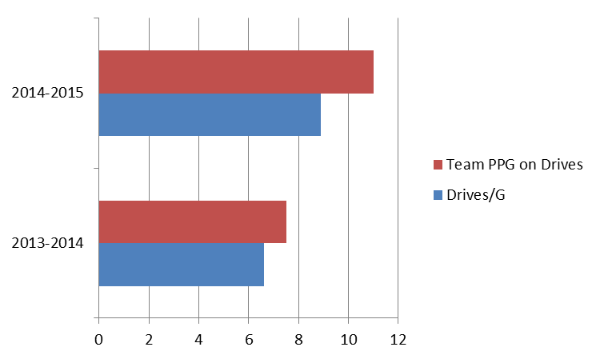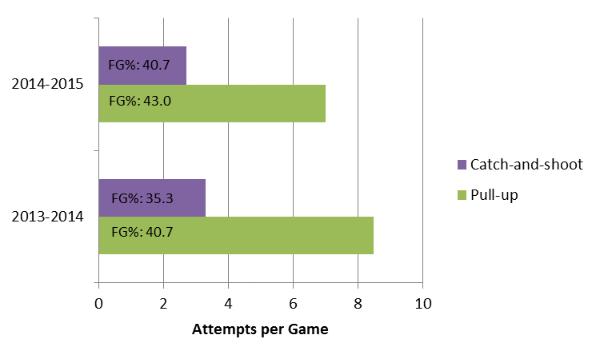Examining the On-Court Evolution of Kyrie Irving

There probably isn’t a player who has changed analytically from last year to this more than Cleveland Cavaliers point guard Kyrie Irving. Many analytics guys were very down on him this time last year, and for full disclosure, so was I. When we found out that LeBron James was coming home and wanting to bring Kevin Love with him, there were thoughts (again, yes, me too) about whether the Cavs should look to move Irving instead of top-overall pick Andrew Wiggins.
And that wasn’t an indictment on Irving necessarily -- in the entirety of LeBron’s career, he had always been the point forward and never really had to balance an offense with a high-usage point guard. Combine that with the analytics on Irving last year -- ESPN's Real Plus-Minus (RPM) rated him at a negative 1.40 -- and it seemed questionable at times whether the Cavs would be able to blend all the pieces.
The evolution of Irving is definitely one of the top storylines of the year. Sure, there are many other developments -- Rudy Gobert, Khris Middleton, and Giannis Antetokounmpo to name a few -- that are intriguing and important as well, but Irving’s is the most title-important. As in, his development could very well lead to a Cavaliers title this season and/or in the future.
Let’s look at what specifically has changed for Irving this year.
Attacking
Despite the addition of LeBron, Irving has increased his drives per game significantly. Even further, his drives have led to increased offensive efficiency this year -- not only for himself but also for his teammates.

His drives have also come with more pull-up attempts, which he’s knocking down much more frequently. His catch-and-shoot attempts are down this year as compared to last, but his efficiency is drastically higher. Many times an Irving shot attempt was the Cavs’ only bail-out hope; this year, more of his shots are within the flow of the offense.

About 39% of Irving’s possessions end with him as the ball handler in a pick and roll. In those plays, the Cavs are scoring at a rate of 0.88 points per possession, which puts Irving in the 81st percentile. For reference, fellow East point guard John Wall is the handler in pick and rolls about the same amount, but the Wizards are scoring at a rate of 0.73 points per possession, good for the 41st percentile.
Part of this (probably a big part) is playing with better teammates. Kevin Love is perhaps the most dangerous pick and roll screener in the world between his ability to post up or pop out for a 3-pointer. He also has better shooters around him this year between J.R. Smith and LeBron on the wings. Better teammates elevate each other’s play, but Irving deserves a lot of the credit as well.
Passing
One of my biggest peeves in the basketball analysis community is the need for everyone to have a definable position. Chris Paul has been the example of how the point guard position should be played, and as a result, all point guards are constantly compared to him. Players dubbed “scoring point guards†are sometimes criticized for that reason -- people claim it’s more important for a point guard to distribute than to get buckets, like Irving, Damian Lillard, or Russell Westbrook.
Westbrook specifically has shown us that positions are going out the window in today’s NBA. The NBA community loves that wings and forwards can create as well as score but don’t like it when point guards can do the same. What an odd way of analyzing a player.
And for Irving’s reputation as a non-passer, well, it’s just not true.

Sure, Irving doesn’t put up gaudy assist numbers, but his secondary assists this year is pretty telling. His mark of 1.7 per game rates sixth in the league, just behind Jeff Teague and Stephen Curry. Speaking of those guys, a highly-efficient NBA offense is going to generate a lot of ball movement around the perimeter to get open shots. As a result, point guards in a highly-efficient offense will lose some of their own assist numbers because the ball is whipping around so much. That doesn’t mean the point guard is a bad passer, it just means he is part of a great offense.
Defense and Efficiency
One of the biggest changes analytically for Irving is on defense. RPM rated him as a positive offensive player last year -- his 1.98 ORPM ranked 19th among point guards -- but his DRPM (60th out of 68) was one of the worst in the league.
This year, DRPM still has him rated as a negative defender overall, but being -0.46 is worlds better than -3.38. The Cavs have given up 104.5 points per 100 possessions with Irving on the court, which is a little better than league-average (105.4 per Basketball-Reference.com). And average is all the Cavs needed from Irving, considering how devastating they are on the other end.
Overall, Irving has a Net Rating (Offensive Rating minus Defensive Rating) on the year of plus-7.0. His true shooting percentage is way up -- .580 this year compared to .533 last season -- as are his efficiency statistics, and the all-encompassing stats, specifically Win Shares per 48 minutes and our own metric here at numberFire, nERD.
| Season | Points per Touch | RPM | WS/48 | nERD |
|---|---|---|---|---|
| 2013-2014 | 0.252 | -1.40 | 0.128 | 3.0 |
| 2014-2015 | 0.260 | 4.37 | 0.180 | 9.1 |
This season has brought with it stellar play from a lot of improving guys in the league.
However, none may be more important this year and the future than the evolution of Kyrie Irving.
















